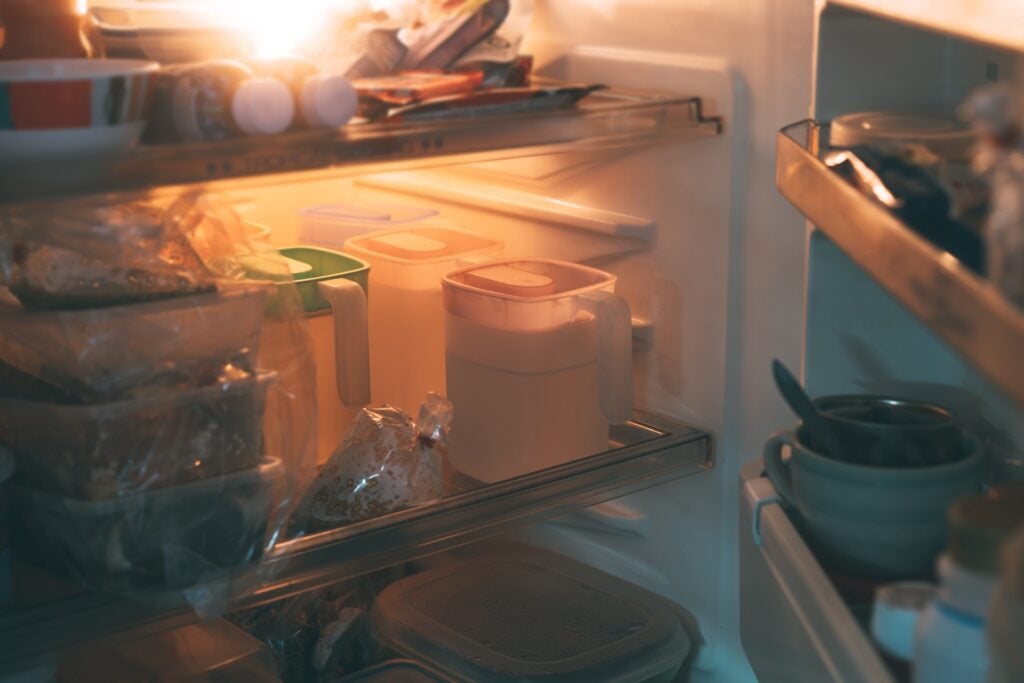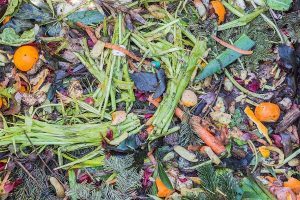
Do you ever double a recipe but never finish leftovers that get pushed to the back of the refrigerator? Take advantage of a buy-one-get-one-free special on produce, even though you know it’s more than you typically use? Forget about an unopened package of salad greens that have begun to turn slimy?
Unfortunately, common situations like these often end with the trash bin. And while the issue of food waste is one that begins well before the home, here are some strategies for shopping, storing, and repurposing that can minimize your kitchen discards.
Shopping tips to minimize food waste
- Prepare weekly menus ahead of time and use shopping lists. This is essential to know what and how much of ingredients to purchase. See our Meal Prep Guide to get started.
- Be wary of impulse buys or specials on foods you normally do not eat. Don’t shop hungry, which can influence how much and what foods you purchase.
- Buy from bulk bins, but not in bulk. Purchase exact amounts whenever possible: single fruits or vegetables (rather than pre-bagged) and whole grains, nuts, and seeds from bulk bins.
- Be particular about fresh produce. Squeeze, smell, and even have a taste if the store allows you. Choose the brightest, freshest looking produce that you can. If it has already softened or started to discolor, the ripening process has begun and will only accelerate at home.
- Be aware of fruits that continue to ripen with time (climacteric) versus fruits that do not ripen further after harvesting (non-climacteric). Ideally non-climacteric fruits are harvested at peak ripeness because there is little you can do if you have purchased an unripe non-climacteric fruit. Climacteric fruits may taste sweeter the longer they are allowed to ripen, but this may be due to gradual water loss, which concentrates the natural fruit sugars.
- Climacteric fruits include apples, apricots, avocados, bananas, cantaloupe, kiwi, mangoes, nectarines, peaches, pears, plums, tomatoes. Store these on your counter at room temperature until desired ripeness, and then refrigerate.
- Non-climacteric fruits include bell peppers, berries, cherries, citrus (oranges, lemons, limes, grapefruit), cucumber, eggplant, grapes, watermelon. Unfortunately sometimes you may purchase a non-climacteric fruit that has been harvested before ripeness (think sour blueberries or oranges!). See below, Reconsider foods that are usually tossed out, on how to use these items.
- Consider buying “ugly produce” or supporting petitions for stores to sell them. These are misshapen fruits and vegetables that may get thrown out because they do not meet the usual standards for appearance.
- It may also be time to reconsider the “fresh is always better” mantra. Food processing techniques such as drying, freezing, and canning can help to extend shelf life. Frozen food, for example, results in 47% less household food waste than fresh food. [1] People may eschew these foods due to perceptions of inferior food quality, like taste or texture, and loss of nutrients. However, it is important to remember that fresh food used past its peak ripeness can result in an even greater loss in quality and nutrients.
- For dried and canned goods that can be stored for months or even years, shop sales but only as much as you realistically will use: whole grains, pasta, nuts, beans, lentils, tomatoes, corn, and sauces.
- Similarly for frozen foods that last several months, shop sales on fruits, vegetables, and breads. Look for labels that state “flash frozen” that indicate the produce has been quickly frozen after harvesting to preserve nutrients.
- For perishables like dairy and eggs, restock only when the current amount is 75% used.
Storing food to minimize waste
- Follow the “First In First Out” method originally designed for food service establishments. Place oldest foods in the front, and plan meals around those ingredients first.
- Keep leftovers in the front. Label the container with a piece of masking tape that lists an “eat by” date. Generally, leftovers keep well for about 3-4 days.
- Try to prep vegetables as soon as you purchase them. Wash, chop, and dry them. Then store in labeled containers in clear view. Immediately stuffing them into the produce bins of your refrigerator increases their risk of being forgotten and not used at peak freshness.
- However, the produce bins can be helpful if used properly. Did you know that they are not just extra storage space, but are controlled for humidity that can either prevent or speed spoilage? Newer refrigerator models have bins with a slider that reads “humidity” or “moisture” control. Sliding the tab in one direction closes off air circulation (higher humidity), and sliding to the opposite end allows airflow (lower humidity).
- Low humidity is beneficial for produce that is not sensitive to water loss and emits high levels of ethylene gas. The low humidity setting allows air to circulate and dispel the gas that would otherwise speed ripening. Produce to place in this bin includes apples, avocado, melons, mangoes, pears, and peaches.
- High humidity is beneficial for produce that is sensitive to water loss and deteriorates quickly in the presence of ethylene gas. The high humidity setting keeps the bin sealed from airflow circulating in the rest of the refrigerator, and protects the produce from gas emitted by other produce. Produce to place in this bin includes leafy greens, herbs, cucumbers, carrots, strawberries, bell peppers, and cruciferous vegetables like broccoli, cauliflower, and Brussels sprouts.
- Remove visibly aging produce and use immediately or compost it, as it can emit gases that speed the ripening of other produce.
- Certain produce like potatoes, onions, tomatoes, winter squash, and basil should be stored at room temperature in a dry area.
- Many foods freeze well, for months up to a year. Remember to label the date it was stored and review your freezer contents regularly. See our Meal Prep Guide for guidelines on recommended refrigeration and freezing times for various foods.
Reconsider foods that are usually tossed out
- Revive wilted lettuce, sagging vegetables, and even herbs. As long as these foods do not have clear signs of spoilage (discoloration, slime, mold), they are worth saving. Because most vegetables contain about 90% water that is gradually lost during storage, adding back water can perk them right up. Slice the vegetables to allow greater surface area contact with water, then soak in a bowl filled with ice water for 15-20 minutes. Dry well before using.
- If fruits begin to brown or become mushy, add to smoothies or baked goods. Add sagging vegetables that can’t be revived to soups or casseroles.
- Use vegetable scraps like carrot peels, celery leaves, parsley stems, mushroom stems, and onion skins to make a stock. Add the scraps to a large stock pot and cover with enough cold water until they float. Bring to a boil, then reduce to medium low and simmer for 30-45 minutes. Using a colander, strain the stock into another large pot. Discard or compost the remaining solids.
- If you purchased a batch of too-tart fruit, add to a smoothie blended with sweeter fruits (banana, pineapple) or use in baked goods like muffins or fruit breads.
- Toast stale bread and place in a food processor to make breadcrumbs as a coating for fish or poultry, or as a filler in a vegetarian meatloaf. Or brush bread slices with olive oil, cut into cubes, sprinkle with garlic powder, and bake at 350°F for 15 minutes to make croutons.
- Eat skins of produce whenever possible: potatoes, cucumbers, kiwi, eggplant, tomatoes, carrots, apples, mangoes. Grate citrus skins like oranges and lemons into sauces or desserts, or onto fish and poultry.
- Consider eating parts of produce that usually get discarded such as squash seeds, pulp, or the tough outer leaves of some vegetables.
- Seeds: Rinse seeds and dry with paper towel. Place in single layer on baking sheet lined with parchment paper. Sprinkle with seasonings of choice (try garlic or onion powder, curry, chili powder, Cajun spice, balsamic vinegar, or cinnamon) and a pinch of salt and pepper. Bake at 375°F for 15-20 minutes or until browned and crisp.
- Pulp: If you juice fruits or vegetables, you are often left with a hefty pile of pulp and fibers. Add the pulp to soups, stews, or sauces as a thickener, or add to smoothies or muffin batter.
- Brussels sprout leaves: After washing and drying Brussels sprouts, follow directions for roasting the seeds above, or see the Brussels Sprouts page for more cooking inspiration.
Composting

Even if we can reduce food waste over time with greater awareness and better planning, some waste is still inevitable. Composting food waste is beneficial to the environment and will help to keep it out of landfills. Compost added to soils enhances its nutrient content and structure, improves its water retention, and reduces the need for fertilizers and pesticides. [3]
Compost requires three ingredients: dead branches and leaves; grass clippings, food scraps or coffee grounds; and water. For further guidance on composting, see EPA: Composting At Home.
Related
- Food Waste: The Big Picture
- Meal Prep Guide
- Sustainability
- Talking sustainability with Dr. Gary Adamkiewicz

